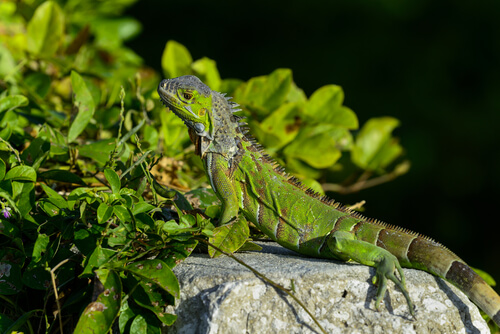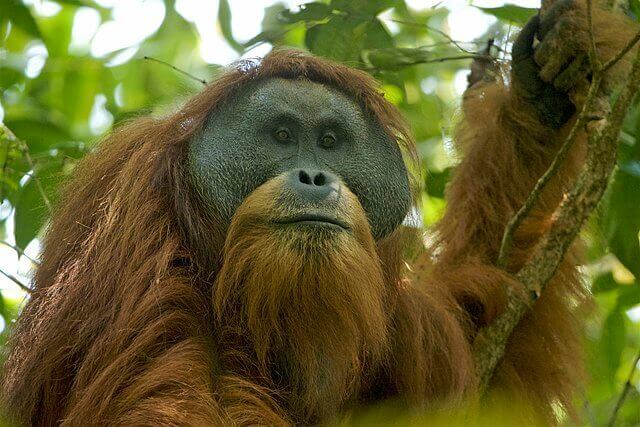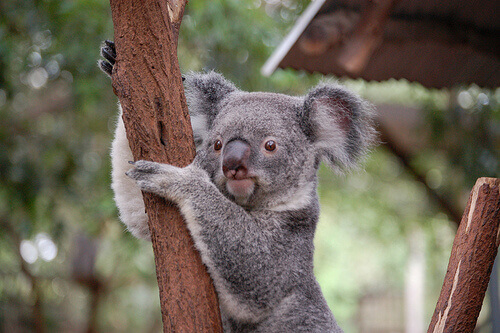Discover Five Different Animals that Live in Trees

Both in the jungle and in the woods, there are many animals that live in the trees… and some never come down from them! Others combine life between branches and the ground. Today, we’ll inform you about several species that use trunks and canopies as their homes.
What animals live in trees?
Tree-dwelling animals have adapted in such a way that their bodies and habits revolve around their ‘big home’, from which many never descend.
For example, monkeys have a prehensile tail that allows them to hang from branches. At the same time, flying squirrels have folds in their skin to glide between the treetops. And, additionally, certain reptiles have very sharp claws to cling to the trunks.
Birds have also learned to create their nests by taking advantage of the shape of the trees. What’s more, insects have the ability to climb without falling thanks to their well-prepared legs. Some of the animals that live in the trees are:
1. Iguanas
The iguana–which appears in the feature photo of this article–is a scaly reptile native to the tropical habitats of Latin America. It consists of two species: The green iguana and the Lesser Antillean iguana. These lizards live in trees more than a meter above the ground and can move easily between branches thanks to their sharp claws.
The iguana is an herbivorous animal measuring up to 5 feet long with a tail almost as long as its body. The neck and back have crests of thorns, and its eyes are prepared to glimpse shadows, bodies, and movements.
2. Owls
This bird has raised feathers that look like ears, and is one of the most frequent inhabitants of the forests. Owls can live in various habitats, although they prefer tree-lined areas.

The owl feeds on almost everything it finds that is smaller than itself (insects, mice, lizards, fish, etc.) and has nocturnal habits. It can hunt in the dark thanks to its highly developed eyesight and its ability to be very quiet.
3. Orangutan
This is a primate–whose scientific name is Pongo–that’s native to Indonesia and Malaysia. The term ‘orangutan’ means ‘man of the jungle’ in the Malay language. This is because they walk almost upright like human beings.

Their front extremities–their arms–are longer than their back extremities–their legs–and they’re also stronger. Long and narrow hands with five fingers allow them to hang from branches. Another inherent characteristic of orangutans is their reddish fur that doesn’t appear on their hands, feet, belly, and chest.
Adult males can measure more than 150 centimeters (5 feet) and weigh about 120 kilos (260 lbs). They’re quite peaceful, except when they fight among their own kind, as they’re very territorial. They sleep a lot–always in the branches of the trees–and make a bed of new leaves every day.
4. Koalas
This is one of the most characteristic animals that live in trees and one of the first that comes to mind. It lives in the coastal areas of Australia and is very easy to recognize. The koala has a robust body with grayish fur, a large head with a black nose, and round hairy ears. At the same time, it has thick claws that allow it to cling to the trunk without problems.

It prefers the open areas of eucalyptus forests since the leaves of this species are its main source of food. The koala leads a very sedentary life and sleeps up to 20 hours a day. It only joins members of its species to reproduce and keep their young very close while raising them (they’re marsupials, not bears). The rest of the time, they live alone.
5. Termites
These insects feed on wood pulp, so they live inside the trees or very close to them. They form nests – known as termite mounds – with millions of specimens divided into castes: Workers, soldiers, and primary and secondary reproducers, as happens with ants or bees. However, in this case, besides a queen, there’s also a king.
Termites are more frequent in Africa, South America, and Australia, mainly inhabiting tropical forests and savannahs. What’s more, their population constitutes 10% of the planet’s biomass.
All cited sources were thoroughly reviewed by our team to ensure their quality, reliability, currency, and validity. The bibliography of this article was considered reliable and of academic or scientific accuracy.
- Goin, F. J. (1995). Los marsupiales. Evolución biológica y climática de la Región Pampeana durante los últimos cinco millones de años. Un ensayo de correlación con el Mediterráneo occidental. Consejo Superior de Investigaciones Científicas, Madrid, 165-179.
- Masciocchi, M. (2019). Termitas. Ediciones INTA. Recuperado el 30 de enero de 2022, disponible en: https://repositorio.inta.gob.ar/handle/20.500.12123/6110